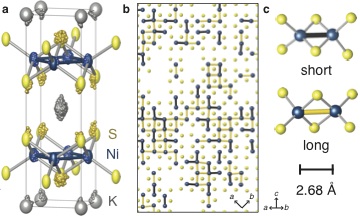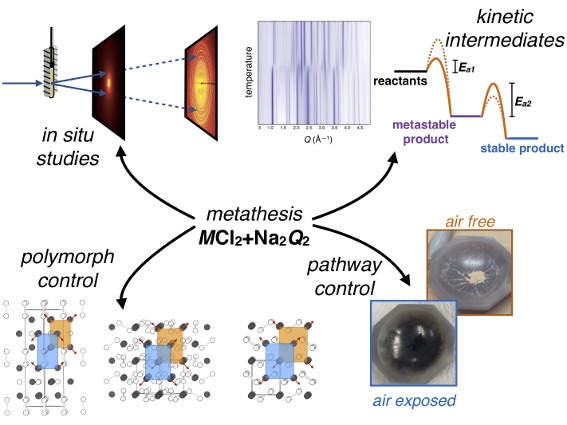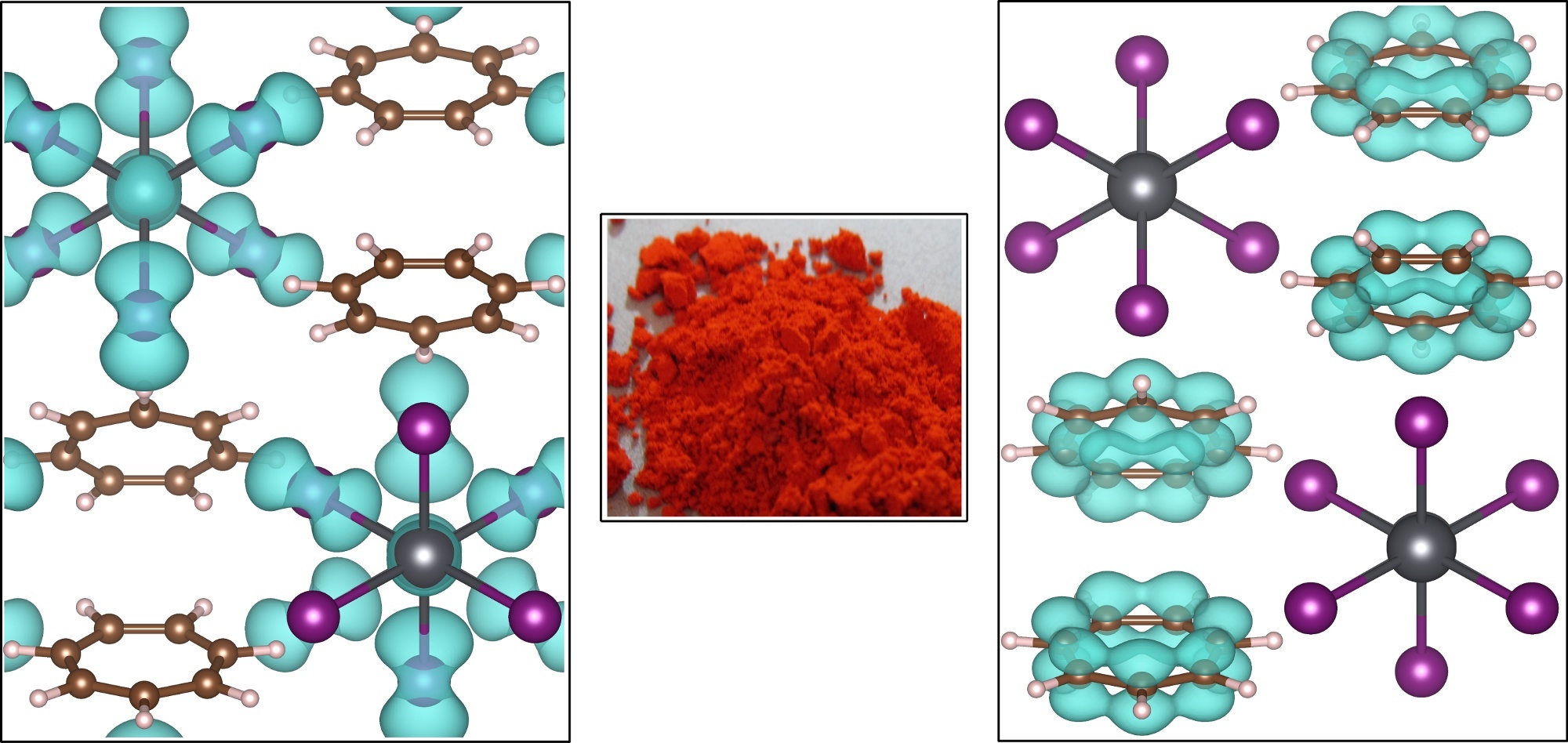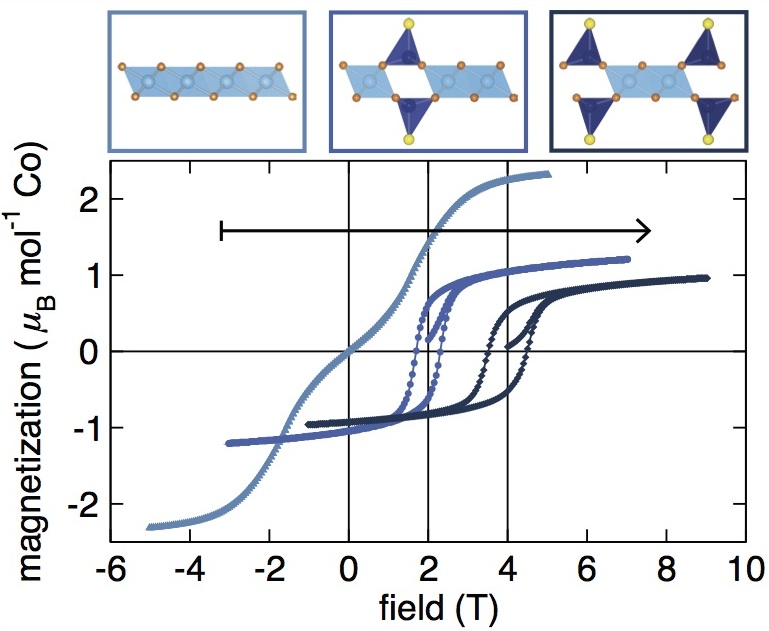
 |
| Projection of a 24000 atom reverse Monte Carlo simulation of KNi2S2 (small spheres) back onto the idealized crystallographic unit cell (large spheres), despite the presence of charge density wave fluctuations within the [Ni2S2] layers giving rise to an electrostatically driven emergent electronic state. [doi] |
an overview: materials and solid-state chemistry
Our research is generally interested in materials by design and structure/property relationships. Why do materials have their functional properties? How can one arrange atoms to give a material advantageous properties? To expand the phase space accessible for functional materials, we are often attentive to preparing materials through the use of kinetic control, as can be found from a combination of low-temperature (T < 300°C) or solution-phase chemical reactions in conjunction with high-temperature (T < 400°C) solid-state reactions.
Our expertise lies in the development of new chemical methodologies
for preparing solids, understanding their structure from atomistic to macroscopic length scales, and relating
the preparatory route and structure to functional properties. In addition to the resources on campus (X-ray diffraction, electron microscopy, magnetometry, etc.), we make extensive use of
X-ray and neutron scattering user facilities across the country. While we are primarily motivated to
understand properties derived from that of electronic mobility and/or spin, the study of biomineralization also
benefit from our approach.
A complete, up-to-date listing of publications can be found in my Curriculum Vitæ as a PDF
If you are interested in an article, but cannot access it, please contact me.current projects:
– new chemical methods for functional materials discovery

|
The discovery and ''design'' of new functional materials has remained somewhat enigmatic (e.g., superconductors); however, the promise of the transformative applications provides the motivation to keep searching (efficient power grids, powerful magnets, computation, etc.). Much of synthetic solid-state chemistry is limited by diffusion, thus necessitating the use of high temperature reactions and close proximity to phases dictated by thermodynamic equilibrium. However, there are countless functional materials, such as high-temperature superconductors that are distinctly metastable (i.e., not stable at ambient conditions or not found on equilibrium phase diagrams), such as high-temperature superconductors. Therefore, new chemical methods that expand the phase space of known materials are required in the materials discovery effort.
representative publications:
A. J. Martinolich, J. R. Neilson, Towards Reaction-By-Design: Achieving Kinetic Control of Solid State Chemistry with Metathesis (Perspective). Chem. Mater., (2017), 29(2), 479-489. [doi]

|
– new materials for photovoltaics
Materials possess the ability to harness the power of sunlight by turning visible light into electrical power. Many of these semiconducting materials are based on the diamond lattice and valence electron count of Si. However, there are many other materials with advantageous crystal-chemical relationships for the efficient conversion of solar photons into usable electricity, as highlighted by the recent resurgence of the use of hybrid inorganic-organic perovskite halide materials in photovoltaic devices. This research area of the group is tasked with elucidating these composition, structure, and property relationships through synthesis, modeling (of atomistic and electronic structures), and physical properties measurements.
representative publications:
A. E. Maughan, A. M. Ganose, M. M. Bordelon, D. O. Scanlon, and J. R. Neilson,
Defect tolerance to intolerance in the vacancy-ordered double perovskite semiconductors
Cs2SnI6 and Cs2TeI6. J. Am. Chem. Soc. (2016), 138(27), 8453-8464.
[doi]
A. E. Maughan, J. A. Kurzman, J. R. Neilson, Hybrid Inorganic−Organic Materials with an Optoelectronically Active Aromatic Cation:
(C7H7)2SnI6 and C7H7PbI3, Inorg. Chem. (2015), 54(1),
370-378.
[doi]

|
– design principles of permanent magnets
Permanent magnet motors and generators also provide advantages for many renewable energy technologies, especially with the need for lightweight and inexpensive electric motors. One approach is to limit the use of heavy and costly lanthanide elements. Our goal is to identify materials and crystal-chemical design principles that increase magnetic energy density. This research area revolves around synthesis of new (and canonical) materials families and their characterization with synchrotron X-ray and neutron scattering techniques; this allows us identify the atomistic and electronic origins of the magnetic interactions defined by the lattice.
representative publications:
J. A. Kurzman, A. J. Martinolich, J. R. Neilson, Influence of interstitial Mn on local structure
and magnetism in Mn1+xSb, Phys. Rev. B, (2015), 92, 184414.
[arXiv],[doi]
J. R. Neilson, B. C. Melot, D. P. Shoemaker, J. Kurzman, R. Seshadri,
D. E. Morse, Understanding complex magnetic order in disordered cobalt
hydroxides through analysis of the local structure, Phys. Rev. B, (2011),
80, 094418.
[doi]